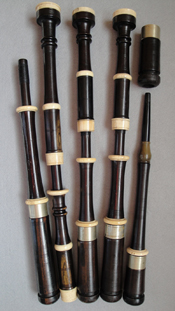Enjoying the pleasures of pipes past
By Jim McGillivray
Editor’s note: This feature article was published originally in 2010. Thanks to a canny reader who noted that it was no longer available, we found that the piece had been lost in a data migration to a new publishing platform. We are pleased to restore the valuable piece, and offer it again to pipes|drums subscribers. In 2014, due to the debacle over importing vintage ivory into the United States, the market for vintage pipes declined, but has since reportedly rebounded, the demand returning to previous levels.

The vintage bagpipe world can become a hobby of its own. Jim McGillivray guides pipes|drums subscribers through the complicated, mysterious, but always rewarding world of antique Highland pipes. In this exclusive feature, he discusses how to identify types of wood, materials used for mounts, hallmarks and the many myths and misperceptions of pipes of the past. Must-reading for anyone with an eye to old-school quality.
The modern piper knows pipe-makers such as Naill, Atherton, McCallum, Shepherd, Dunbar, Walsh, Dunbar or Henderson/Hardie. But how many know of Glen, MacDougall, Center, Thow, Peter Henderson, Lawrie, MacDonald, MacPhee or Robertson?
How many might know that African blackwood does not necessarily make the best bagpipes? Or that blackwood and ebony are not in fact “the same,” as many people believe.
How many might guess that a crack clear through a 150-year-old drone piece is merely a bump in the road on the tonal journey of that instrument?
The world of vintage bagpipes is an intriguing one. It is also an important one for pipers, as great old instruments of the 1800s and early 1900s continue to surface, looking to be played and demanding special and dedicated care.
The earliest playable three-droned Highland pipes date from perhaps the mid-1700s. We say ‘perhaps’ because it is almost impossible to date many vintage pipes, particularly pipes with no makers’ stamps. Dating is often guesswork based on materials used and the styles and shapes of the mounts. Many of the oldest pipes were made from . . .

I’m surprised there are not a number of comments or questions on this article – a lot of information, experience and work in the article, much of which was new to me. So glad the article was retrieved!